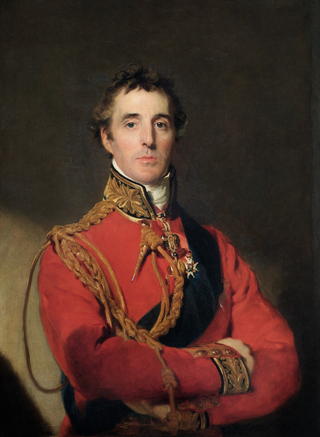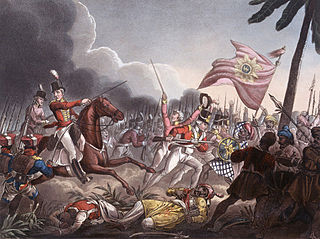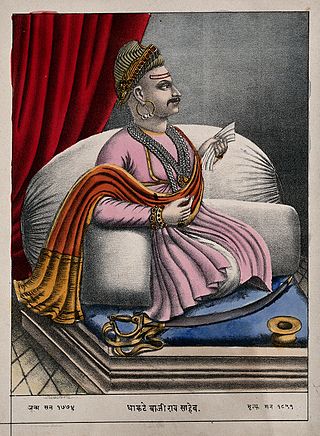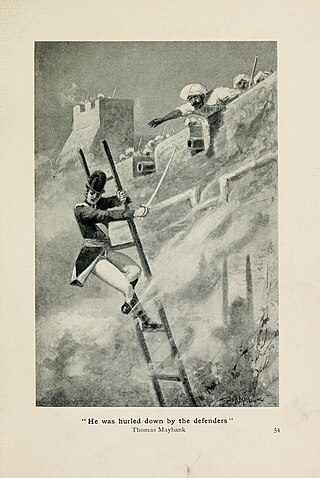Related Research Articles

Arthur Wellesley, 1st Duke of Wellington was an Anglo-Irish army officer and statesman who was one of the leading military and political figures in Britain during the late 18th and early 19th centuries, twice serving as Prime Minister of the United Kingdom. He is among the commanders who ended the Anglo-Mysore Wars when Tipu Sultan was killed in the fourth war in 1799 and among those who ended the Napoleonic Wars in a victory when the Seventh Coalition defeated Napoleon at the Battle of Waterloo in 1815.

Richard Colley Wellesley, 1st Marquess Wellesley, was an Anglo-Irish politician and colonial administrator. He was styled as Viscount Wellesley until 1781, when he succeeded his father as 2nd Earl of Mornington. In 1799, he was granted the Irish peerage title of Marquess Wellesley of Norragh. He was also Lord Wellesley in the Peerage of Great Britain.

The Maratha Confederacy, also referred to as the Maratha Empire, was an early modern polity in the Indian subcontinent. It comprised the realms of the Peshwa and four major independent Maratha states often subordinate to the former. It was established in 1674 with the coronation of Shivaji as the Maratha Chhatrapati and recognised by Emperor Bahadur Shah I as a tributary state in 1707 following a prolonged rebellion. Following this, the Marathas continued to recognise the Mughal emperor as their nominal suzerain, similar to other contemporary Indian entities, though in practice, imperial politics at Delhi were largely influenced by the Marathas between 1737 and 1803.

The Battle of Assaye was a major battle of the Second Anglo-Maratha War fought between the Maratha Confederacy and the British East India Company. It occurred on 23 September 1803 near Assaye in western India. An outnumbered Indian and British force, under the command of Major General Arthur Wellesley, defeated the combined Maratha army of Daulatrao Scindia and the Bhonsle Raja of Berar. The battle was Wellesley's first major victory and the one he later described as his finest accomplishment on the battlefield, even more so than his more famous victories in the Peninsular War, and his defeat of Napoleon Bonaparte at the Battle of Waterloo.

The Second Anglo-Maratha War was a large conflict within the Maratha Confederacy involving the British East India Company. It resulted in major loss of territory for the Marathas, including regions around Delhi and in present-day Gujarat falling into direct Company rule.

The Battle of Laswari took place on 1 November 1803 near Laswari village, Alwar. It was part of the Second Anglo-Maratha War.

The Battle of Argaon took place on 29 November 1803, between the British under the command of Major-General Arthur Wellesley and the forces of the Bhonsles of Berar and the Scindias of Gwalior.

Gerard Lake, 1st Viscount Lake was a British general. He commanded British forces during the Irish Rebellion of 1798 and later served as Commander-in-Chief of the military in British India.

Baji Rao II was the 13th and the last Peshwa of the Maratha Confederacy. He governed from 1795 to 1818. He was installed as a puppet ruler by the Maratha nobles, whose growing power prompted him to flee his capital Poona and sign the Treaty of Bassein (1802) with the British. This resulted in the Second Anglo-Maratha War (1803–1805), in which the British emerged victorious and re-installed him as the titular Peshwa. In 1817, Baji Rao II joined the Third Anglo-Maratha War against the British, after they favoured the Gaekwad nobles in a revenue-sharing dispute. After suffering several battle defeats, the Peshwa surrendered to the British, and agreed to retire in return for an estate at Bithoor and an annual pension.

The Cis-Sutlej states were a group of states in the contemporary Punjab and Haryana states of northern India during the 19th century, lying between the Sutlej River on the north, the Himalayas on the east, the Yamuna River and Delhi District on the south, and Sirsa District on the west. The small Punjabi kingdoms of the Cis-Sutlej states were under influence of Marathas, until the Second Anglo-Maratha War of 1803–1805, after which the Marathas lost this territory to the British. During the British period, some of the cis-Sutlej were annexed by the British due to the doctrine of lapse.
Loharu is a city, municipal committee and assembly constituency, near Bhiwani City in the Bhiwani district of the Indian state of Haryana. It is the administrative headquarters of one of the four administrative sub-divisions of the district and covers 119 villages. It is also a railway junction station.

Mahadaji Shinde, also spelled Scindia, was a Maratha military general and statesman who served as the sixth maharaja of Gwalior from 1768 to 1794. The fifth and youngest son of Ranoji Scindia, the founder of the Scindia dynasty, and is reputed for having restored the Maratha rule over North India and for modernizing his army.

The Gwalior State was a state within the Maratha Confederacy located in Central India. It was ruled by the House of Scindia, a Hindu Maratha dynasty. Following the dissolution of the Confederacy, it became part of the Central India Agency of the Indian Empire under British protection.

Daulat Rao Scindia also conferred with the title "The defender of Delhi" was the Maratha Maharaja of Gwalior state in central India from 1794 until his death in 1827. His reign coincided with struggles for supremacy within the Maratha Empire, and wars with the expanding East India Company. Daulatrao played a significant role in the Second and Third Anglo-Maratha wars. While most Indian rulers had accepted British rule, Scindia's kingdom maintained its independence even as late as 1832 and continued collecting Chauth (taxes) from other neighbouring states and dependent Kingdoms till 1886. As per an answer given by Mill in a Parliamentary Committee in Britain on February 16, 1832, on the status of Scindia's kingdom it was mentioned that “he was independent.” This Committee finally reported to Parliament that “within the Peninsula, Sindhia is the only prince who preserves the semblance of independence.”
Anjangaon is a city and a municipal council in Amravati district in the state of Maharashtra, India. Anjangaon City got the status of Municipal Council in 1930. It is the first municipal council established in Amravati district and the second biggest council as well. Anjangaon Surji Tehsil was established in 1981. It is technically made up of two main zones, Anjangaon and Surji, on either side of Shahanur River, and is called Anjangaon-Surji in combination. It is called a "Banana Hub of Vidarbha" as it is a large producer of bananas and a hub of medicinal plants - Piper longum and Safed musali.

Yashwant Rao Holkar (1776–1811) also known as Jaswantrao Holkar belonging to the Holkar dynasty of the Maratha Confederacy was the Maharaja of the Indore. He was a gifted military leader and educated in accountancy as well as literate in Persian, Marathi and Urdu.
Major General James Stevenson was a British East India Company cavalry officer who saw extensive service throughout the Indian subcontinent. He commanded a cavalry squadron at the battles of Seringapatam and Mallavelly, and in late 1800 he was temporarily appointed as district governor of Mysore. He took part in the Second Anglo-Maratha War in which he served as Major General Arthur Wellesley's senior subordinate and led the successful assaults on the Maratha strongholds at Jalna, Burhanpur and Asirgarh. Stevenson was promoted to major general in January 1805, but he died while aboard a ship returning to England later that year.
Argaon, or Argaum is a village in the Ratnagiri district of Maharashtra state in (India). Ratnagiri is a coastal district on the Arabian Seafront. The landmass on the western part of Maharashtra along the Arabian Sea, sandwiched between the sea and a mountain range named Sahyadri, is known as Konkan. Argaon is situated in the foothills of the Sahyadri mountains.

Arthur Wellesley, 1st Duke of Wellington,, was one of the leading British military and political figures of the 19th century. Often referred to solely as "The Duke of Wellington", he led a successful military career in the Indian subcontinent during the Fourth Anglo-Mysore War (1798–99) and the Second Anglo-Maratha War (1803–1805), and in Europe during the Napoleonic Wars (1803–1815).

The siege of Ahmednagar was the first battle of the Second Anglo-Maratha War fought between the Maratha Confederacy and the British East India Company. When he determined that a long defensive war would ruin his army, Wellesley decided to act boldly to defeat the numerically larger force of the Marathas.
References
- ↑ "Haryana and its Changing Matters" Haryana, a Historical Perspective. Retrieved 2015-09-10.
- ↑ The dispatches of Field Marshal the Duke of Wellington, K. G ..., Volume 1 By Arthur Wellesley Wellington (Duke of). 1834. p. 571. Retrieved 4 February 2010.